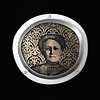SANDRA NOBLE GOSS
1946-2022Home | Portfolio | About | Tech Notes
Technical Notes: Photocopy Resist for Etching
This is an archived page.

PHOTOCOPY RESIST FOR ETCHING
©Sandra Noble Goss[These advanced techniques assume that you have basic jewellery and metalworking skills. We offer these technical papers, originally presented as workshops, in a spirit of sharing information. We assume no liability for safety and health issues -- those are your responsibility. Please read Artist Beware by Michael McCann or The Artist's Complete Health & Safety Guide by Monona Rossol.]
CAUTION: Although etchant is not a pure acid, it is a "corrosive poison". Read the label: avoid contact with eyes and skin, use with adequate ventilation. Read the general etch guidelines page first.
Photocopied images may be transferred onto metal with heat and the ink will act as a resist to the etchant. Laser printers use the same heat sensitive ink as photocopiers, and can be used in the same manner.
- TO MAKE THE IMAGE:
- Drawings: use black markers.
- Paintings: use black ink or black paint.
- Photographs: should be screened (either with a photocopy screen acetate or by screening a scanned image on a computer). If you want a high contrast image, do not screen the photographic image.
- Text: text printed on a computer may be used. Remember to reverse the letters; once they are applied to the metal they will read backwards.
TO MAKE A PHOTOCOPY RESIST:
I suggest using a product called "PnP-Blue" (Press-n-Peel - Blue) Transfer Film which is an acetate sheet coated with a soft blue finish. This product is used for printing copper circuit boards and is available from sources on the internet. (I purchase it from Electronix Express: http://www.elexp.com/pro_npb5.htm or 1-800-972-2225)
1. Photocopy the image using the blackest print you can obtain while still maintaining a clear white background. You may have to experiment with various photocopiers. Test with paper first. Look for a machine that will lay down a very opaque black image (check large black areas to make certain ink isn't too thin in the centre of the black area).
2. To reverse an image or text you can first photocopy onto acetate, then flip over the image printed on the acetate and print again. Letters should then appear to be backwards. When applied to the metal, the letters will be the right way around.
3. Photocopy the image onto the PnP-Blue paper (pass PnP-Blue through the machine with the dull side up to receive the ink).
4. Clean metal (same instructions as for ink resist).
5. Use a regular household iron to apply the ink to the metal. The iron should be hot (all irons are different so you will have to experiment with the temperature settings - begin with low to middle range for steam -but do do not use steam in the iron). Ideal temperature is 200 - 225 degrees F.
6. Place PnP-Blue onto the metal with the image face down (contacting the metal). It is recommended to place the metal on a piece of smooth wood to act as an insulator. Carefully press the iron onto the acetate. Move the iron gently to make certain the entire design is heated, but do not move the acetate -- when the ink melts it can slip. Hold the iron in place, applying gentle pressure, for about 45-100 seconds. The larger the image, the longer it will take.The image will show up more clearly through the acetate when it is ready. Overheating will cause the black ink to spread out (bleed) from the edge of the image.
7. Allow metal and PnP-Blue to cool to a temperature that is easy to handle (about body temperature). Carefully peel back the film beginning at one corner and rolling it up and away from the metal.
9. If the edges of the ink on the metal have spread out from the edge, they can sometimes be corrected by brushing with a small brush (like a toothbrush). Any flaws may be corrected using permanent markers.
ETCH THE METAL:
Place metal in ferric chloride solution. Once design is etched, remove the ink with lacquer thinner, fine emery paper or steel wool. Refer to the etch page for more details.
Photocopied designs on paper can also work as a resist. They do not always give the precise results of the PnP-Blue film, but are much less expensive and handy. Photocopy images to get the darkest, blackest and cleanest image possible. Use that paper and apply to the metal the same as the film. Iron until ink has melted onto the metal surface. To remove the paper- soak in water until paper lifts off.
|
SAFETY PRECAUTIONS: Always use Etchant in well ventilated area (preferably under a fume hood). DO NOT INHALE FUMES! Read the label on the bottle. Etchant will stain fingers and clothing brown - ALWAYS WEAR RUBBER OR LATEX GLOVES. WEAR GLOVES WHEN USING METHYL HYDRATE - it is absorbed directly through skin. Use it in a well ventilated area (preferably under a fume hood). |
©Sandra Noble Goss
TECHNICAL NOTES
Etching
Silver Etching
Photocopy Resist
Roller Printing
Multi-metal Lamination